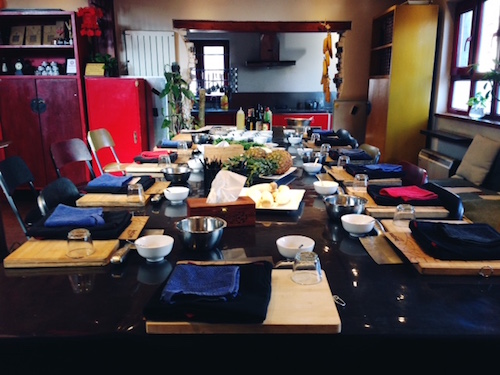
In Beijing’s expat circles, everyone and their mother has heard of or been to The Hutong. Founded by Australians Mark Thirlwall and Stacey Shine in 2007, this cultural exchange center offers varied menu of cooking classes, education programs, teambuilding events, culinary tours, day tours, extended China trips, and more. Last Sunday, I finally got to try one of the center’s famous cooking classes with a few friends.
We opted for a private cooking class to celebrate my boyfriend’s birthday. At RMB 350 per person (compared to RMB 300 for regular group classes), it wasn’t cheap. The price included local beer, soft drinks, and tea. For an extra RMB 100 per person, participants get a branded apron.
We originally wanted to bring our own wine but balked at the RMB 80 per bottle corkage fee. The Hutong does sell its own house wines – an Australian red and a French white – for RMB 180 per bottle.
The arrangements themselves were easy enough; I booked the class with less than a week’s notice and wired a deposit of RMB 2,100 to confirm our spots. Note that private cooking classes must have a minimum of six people and a maximum of 13. The duration is around 2.5 hours.

The class took place on a brisk Sunday afternoon. From Beixinqiao subway station exit C, we followed The Hutong’s excellent map and arrived at a large siheyuan with several rooms. A friendly staff member led us to an airy room with lots of cushions and natural lighting – a welcome respite from the cold.
Our host for the day, The Hutong’s chef and nutritionist Sophia Du, introduced herself and had the ayis pour us hot tea as we waited for the rest of the group to arrive.
Ingredients and seasonings were neatly laid out for the three Yunnan dishes we’d be making that day: seasonal mushrooms with black cardamom, grilled chicken with garlic and coriander dressing, and pineapple rice. For the class, each person got a cutting board, an apron, a Chinese chef’s cleaver, a hand towel, and a takeaway folder with written recipes.




Du began the class with an introduction to Yunnan cuisine and passed around ingredients for us to taste. We also received a primer on holding and using the intimidating but surprisingly versatile Chinese cleaver or chef’s knife (菜刀 cai dao). (To learn more, click here for a video series on knife skills starring Chinese-American chef Martin Yan.)
In the interest of time and practicality, the dishes were prepared collectively with different people taking on different tasks. For example, a friend and I were in charge of hollowing out the pineapples while another pair were tasked with marinating the chicken thighs.
When volunteers were solicited to pan-fry the chicken and stir-fry the mushrooms, the rest of us gathered round to watch and take pictures. The highlight was when we took turns grasping a handful of mint leaves and dropping them with a flourish into a hot pool of oil.
The herbs were left to sizzle and pop for a few seconds, then fished out with a mesh skimmer and left to dry on a paper towel. The result was unexpectedly beautiful, the brilliant green of the leaves a far cry from the sad gray things you usually see at local Yunnan restaurants.

Throughout the class, Du also taught us a number of tips and tricks related to Chinese cuisine, like how to gauge whether oil is hot enough with a wooden chopstick (stick it in the wok and watch for little bubbles around the tip) and choose a good soy sauce (it’s all in the protein content).
At the end, we got to eat the fruits of our labor together and get a closer look at The Hutong’s products, which are cleverly incorporated into the class. We were continuously plied with two of the center’s tea blends – Mandarin Vanilla and Mint Chocolate – and prepped vegetables with its own line of cleavers, all of which were available for purchase. At RMB 180 (RMB 200 with a finger guard), the cleaver would make a great gift for a home cook.

I did have a few quibbles with the class. The biggest issue was that we didn’t have enough to eat. Between the ten of us, we had to share four modest servings of pineapple rice (the equivalent of two pineapples), two plates of stir-fried king oyster mushrooms with mint leaves, and two plates of pan-fried chicken. There was plenty of rice to go around, but it wasn’t enough to make us forget the insufficient amounts of food.
I was also puzzled by the fact that the pineapple cubes we’d hollowed out were taken away; we figured they’d be mixed in with the glutinous rice and purple rice and put back into the pineapple shells for steaming. When I mentioned this, we were told the ayis took the cubes away and whether we’d like to have them for dessert. Well, yes, I said, we might as well since we did the work. It makes me wonder what they would’ve done with the pineapple if I didn’t said anything.

We also had a hiccup where one person didn’t show up and we discovered at the end of class that The Hutong has a policy where participants must shoulder the cost for absentees.
However, Du was kind enough to waive the penalty and told us to inform our friend so this situation wouldn’t happen again. It was only later that I realized I’d miscounted the number of people coming – it was ten all along, not 11.
Though the fault lay with me in this instance, it’s important to take note of this policy since the only mention it gets is in The Hutong’s confirmation email. If you often skim emails in the middle of a busy workday (like me), this detail is easy to miss.
Quibbles aside, the private cooking class was a great experience and I’m glad I finally got the opportunity to do it. I’ll definitely be replicating the stir-fried king oyster mushrooms and pineapple rice at home – but perhaps with the addition of some fresh pineapple cubes in the latter dish.
Sijia Chen is a contributing editor at beijingkids and a freelance writer specializing in parenting, education, travel, environment, and culture. Her work has appeared in Travel + Leisure, The Independent, Midnight Poutine, Rover Arts, and more. Follow her on Twitter at @sijiawrites or email her at sijiachen@beijing-kids.com.
Photos: Sijia Chen



